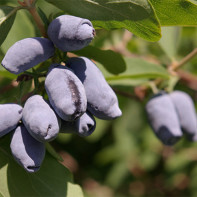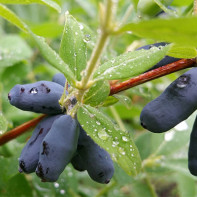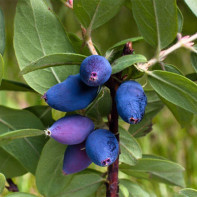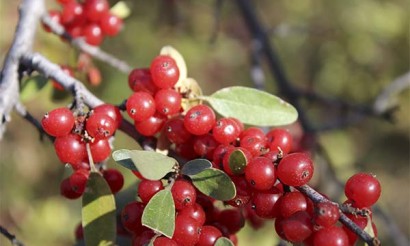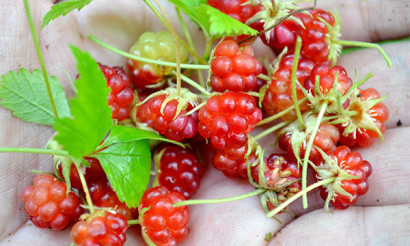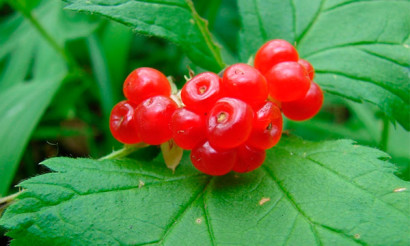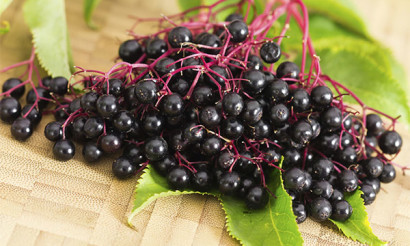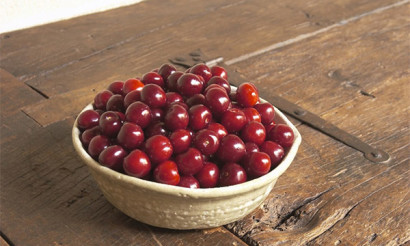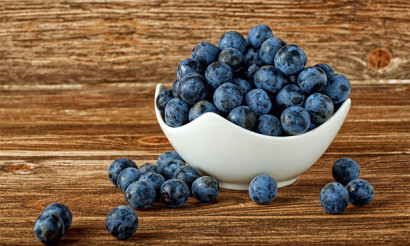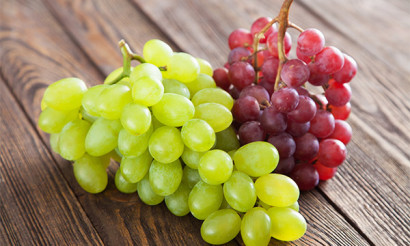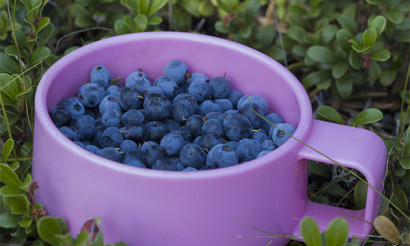Honeysuckle: useful properties and contraindications
Honeysuckle is used not only for fresh consumption. Of it make jam, jams, morses and compotes. She also received wide application in cosmetology and folk medicine. But it is important to use the gift of nature correctly.
- What is honeysuckle and how it looks
- Where does it grow
- Types
- How to distinguish edible from inedible
- The difference between honeysuckle and blueberry
- Composition and calories
- Useful properties of honeysuckle
- General benefits
- For Women
- For Men
- Pregnancy
- Breastfeeding
- For children
- Weight loss
- What are the different parts of honeysuckle useful for
- Leaves
- Bark
- Branches
- Flowers
- Honeysuckle in medicine
- For diabetes
- When pancreatitis
- At gastritis
- In constipation
- For gout
- For the Liver
- Honeysuckle-based folk medicine recipes
- Honeysuckle in cosmetology
- For Face
- For Hair
- Harm and contraindications
- Harvesting and storage
- Can I freeze?
- Can I Dry?
- What can be made of honeysuckle: Recipes
- Jam
- Jam
- Compote
- Mors
- Wine
- Can I eat ornamental honeysuckle berries
- Interesting facts about honeysuckle
What is honeysuckle and what does it look like
Today there are about 200 varieties of honeysuckle, which differ in their taste and appearance. It is a shrubby plant that is noted for its ornamental qualities. Honeysuckle can be found in many garden plots.
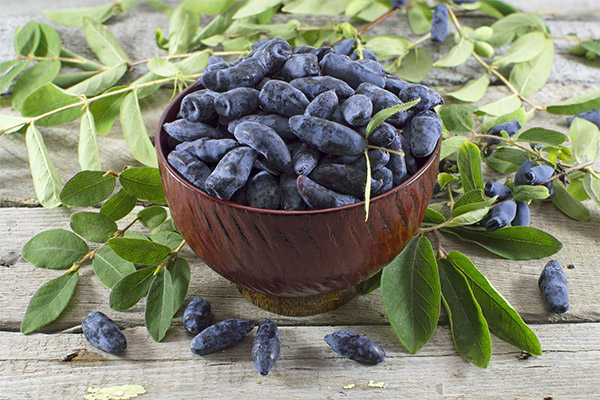
There are not only ornamental species, but also edible ones. The berries of the plant are quite suitable for food and have many useful properties.
Shrubs, regardless of species, are upright, but there are also wicker varieties. The berries are slightly elongated, blue in color. They resemble blueberries in their appearance.
Where does it grow?
Honeysuckle is widely distributed throughout the Northern Hemisphere and grows well in latitudes with a temperate climate. Wild representatives of the plant are also found in Asia in the southeast.
In the Altai region and Europe, the plant can be found in parks and gardens. But they often have a decorative function, and their berries are inedible.
Shrubs are frost-resistant, unpretentious in care and distinguished by early ripeness.
Types
The most common are the following species:
- Caprifolium honeysuckle. Homeland - Southern Europe, massively grows beyond the Caucasus. In culture, this type of plant is used for quite a long time (decorating arches, arbors and so on).
- Clinging. Area of distribution: Europe, Asia and North Africa. Blooms are abundant.
- Tatar. In nature grows in Kazakhstan, along the Middle Volga, from Siberia to Altai. It is often grown in gardens.
- Alpine. Flowers are odorless, yellow inside and reddish outside. The berries are shiny and red.
- Golden. The flowers are golden yellow in color with a honey aroma. The ornamental red berries are especially appreciated by gardeners.
- American. A heat-loving plant, can be grown in our country, but only with the use of shelter for the winter.
How to distinguish edible from inedible
There are many species of the plant, among which there are both edible and non-edible. It is not difficult to distinguish between them.
The berries, which can be eaten, have a blue-blue color and a pronounced waxy patina. They can be elongated, oval or cylindrical in shape. They taste pleasant enough, sweet, and many varieties lack bitterness.
Those berries that should not be eaten are small in size. They are small, attached to the branch with a short peduncle. The color of the fruit can be orange, black and red. It is important to know that they are not only inedible, but can also be dangerous to life and human health, as the inflorescences contain poison. Popularly, they are nicknamed "wolf berry."
What is the difference between honeysuckle and blueberry?
Edible honeysuckle is confused by many novice gardeners with garden blueberries. The berries can be distinguished by their appearance and taste. Honeysuckle is oblong and may be slightly bitter.
Blueberries are always sweet, round. The fruits have a dark blue or black color with a blue tint. The berries are quite large, but no larger than honeysuckle.
Composition and calories
Honeysuckle is useful for the human body, which is due to its chemical composition. Berries contain many vitamins, minerals and nutrients:
- Vitamin C. Necessary for the immune system. Characterized by anti-inflammatory, antiviral properties. In addition, copes well with tissue healing, has antiseptic properties.
- Vitamin P. Widely used in allergies. Also helps accelerate tissue healing, strengthen the walls of blood vessels, reducing their permeability. Allows it to reduce inflammation, has an antioxidant effect, activates the synthesis of prostate hormones, controls blood cholesterol levels.
- Carotene. This is the name of the vitamin A. It takes part in many chemical processes, is responsible for the synthesis of hormones.
- B vitamins. Includes several different vitamins that are involved in the metabolic process and accelerate the regeneration process.
Honeysuckle also contains various trace elements such as phosphorus, sodium, iron, potassium, calcium. All of them have a positive effect on the general state of the body and help ensure the normal functioning of all systems.
Honeysuckle also contains such chemical elements as copper, manganese, boron, iodine, silicon.
Among other things, the fruit also contains a number of bioactive additives. These include:
- Pectins. They reduce inflammation, have an enveloping property, and accelerate the regeneration process.
- Tannins. According to the dosage have an astringent or irritant effect. Also have an antibacterial effect, speeding up the healing of tissues.
- Anthocyanins. They are present in fruits as dyes. But also have a positive effect on the body. They are distinguished by their antioxidant properties, slow down the spread of tumor processes, support the performance of the bone marrow.
- Sugar. It is a source of energy for the human body.
- Organic acids. It is necessary for the blood circulation, and it also participates in the digestive process.
Honeysuckle is rich in various substances, providing invaluable benefits for the body. This is why it is widely used in folk medicine.
The caloric value of berries is only 42 kcal per 100 grams. Thus, it is not only useful, but also helps not to gain excess weight, which allows using it in weight loss diets.
Useful properties of honeysuckle
General benefits
Due to its rich composition, honeysuckle has many beneficial properties.
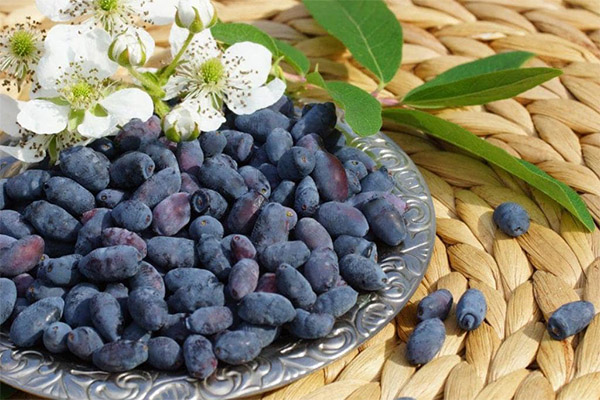
- First of all, it strengthens the walls of blood vessels, reduces their permeability, which has a positive effect on the work of the heart muscle.
- The fruits of the plant perfectly cope with the signs of IBS and sudden changes in blood pressure. Honeysuckle flowers are used in folk medicine to relieve headaches, migraines, and fatigue.
- Honeysuckle contains pectins, which have a positive effect on the digestive system, preventing the processes of fermentation and putrefaction. It is used as an antimicrobial and is used in the treatment of diarrhea caused by an infectious lesion. The berries have an enveloping property, which allows you to protect the intestines from the negative effects of a number of factors. That is why the fruit is used in folk medicine for gastritis, ulcers and other gastrointestinal diseases.
- The berries of the plant also help cope with skin diseases, since they contain special substances - catechins. Fruits are also used to relieve inflammation that affects the mucosa of the throat, mouth. Leaves are used to prepare a tincture that is used to rub the eyes affected by conjunctivitis.
- Honeysuckle is also rich in vitamins, which allows it to cope well with a reduced immunity. Folk healers recommend using the berries in the fall and spring during colds and to treat acute respiratory infections.
- The fruit copes well with tissue swelling, and is used to treat diseases in which fluid begins to accumulate in the abdominal cavity.
For women
Regular use of honeysuckle can prolong the youthfulness of the skin, slow down the aging process, return the skin to its normal color. The berries are useful in their fresh form. In addition, the fruit has a positive effect on the figure, as they are low in calories and help speed up the metabolism.
For men
Honeysuckle is recommended for men after 40 years of age, as it has many vitamins and minerals in its composition, which helps to slow down and prevent hair loss.
When pregnant.
You should use berries with caution and in small quantities during pregnancy. During pregnancy, it brings invaluable benefits, as it helps to reduce and prevent the appearance of edema of the extremities, which is a frequent problem.
Honeysuckle regulates the cardiovascular system, replenishes the body with useful substances, which is very important during pregnancy.
Experts in some cases recommend that future mothers eat a few berries before a meal.
When breastfeeding
It is important to know that honeysuckle should be abandoned in the first months of life of the child, since all the substances contained in the berries get into the breast milk. This can cause allergies in the baby, disorders of the digestive process.
You can eat the fruit only six months after delivery. They are added to the diet gradually, starting with a few berries. If the baby shows signs such as rash, redness of the skin, itching, diarrhea or colic, you should postpone the introduction of honeysuckle.
Fruits for a nursing mother will bring invaluable benefits, as they are rich in vitamins, trace elements and nutrients, which are necessary during this period.
For kids
Honeysuckle can also be given to children. It contains a huge amount of vitamins that support the immune system and help cope with colds.
Berries can be used as an addition to breakfast, for example, for porridges, compotes, morses, jellies.
When losing weight
Honeysuckle fruits have a small caloric value and that is why they do not harm the figure. Dietitians recommend adding the berries to their diet to those who follow special diets for weight loss.
In addition, honeysuckle has the property to reduce appetite even in the smallest quantities, and is excellent for desserts.
Honeysuckle morsel is also useful for losing weight. It has a diuretic effect and removes from the body excess fluid.
What are the usefulness of the different parts of honeysuckle
In folk medicine and cosmetology, not only the berries of the plant are used. Branches, leaves and bark of the shrub have useful properties.
Leaves .
They are quite suitable for food. For many years, folk healers use them to prepare infusions, decoctions, compotes. Of particular benefit is a tea based on honeysuckle leaves.
Fresh they can be used as an antimicrobial, as they help to destroy pathogens. The leaves are suitable for relieving inflammation on the skin, especially after wounds and burns. They are applied to the place of trauma of the upper layer of the epidermis.
To make a healthy tea, the leaves are harvested and dried in the sun. Only undamaged leaves should be chosen. Once dry, they can be stored in a cloth bag for a long time and added to tea if desired.
Bark
The bark of the shrub is infused in boiling water and infused. The infusion perfectly copes with diarrhea, regardless of the cause of its appearance. In addition, the resulting solution is used to rinse the mouth or treat wounds, as the substances included in the bark allow the destruction of bacteria and viruses.
In folk medicine, honeysuckle bark is used for dropsy, colitis of various types.
The branches .
They are cut, dried and used to prepare a broth. It helps to remove excess water from the body and is widely used in folk medicine for abscesses, when water accumulates in the abdominal cavity for certain reasons.
The branches, once dried, can also be stored in a cool, dry place for a long time.
Flowers
When the honeysuckle blossoms are in bloom, you can collect the flowers, as they also have a number of useful properties. First of all, an infusion based on them is used to eliminate pain in the stomach. Flowers have not only analgesic, but also an enveloping effect, helping to protect the mucosa of the gastrointestinal tract from the negative effects of various factors. That is why they are widely used in the treatment of gastritis, ulcers and other diseases of the digestive tract.
Infusion based on honeysuckle flowers is also used to wash the eyes when the organ of vision is affected by conjunctivitis.
The solution can also be used internally. In this way it is possible to eliminate the inflammatory process, which spreads to the ureters.
Honeysuckle in medicine
Honeysuckle has been used for many years in folk medicine as an additional treatment for a number of diseases, eliminating unpleasant symptoms and improving health.
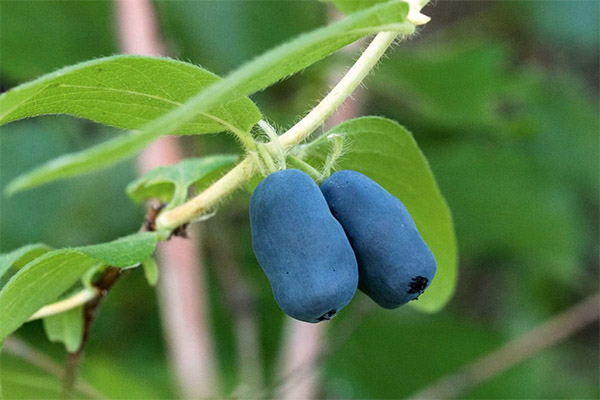
When diabetics.
Honeysuckle is allowed to use for people suffering from diabetes, regardless of the type of the disease, despite the fact that the berries contain sugar. But they should be eaten with caution and in small portions. In addition, diabetics are prone to gaining excess weight. Honeysuckle will not only maintain glucose levels, but also keep the figure due to the low caloric content.
Important: The glycemic index of honeysuckle is 20-25 units.
Pancreatitis
Pancreatitis in medicine is called a disease characterized by inflammation of the pancreas. There are several reasons for the development of the disease. It is important to see a doctor in time, who will prescribe treatment.
As an additional therapy, you can use honeysuckle fresh, as well as morsels and tinctures based on it. It has anti-inflammatory properties and helps to reduce pain. But before introducing it into the diet, it is important to consult with your doctor.
With gastritis
The disease is characterized by inflammation and the development of dystrophic changes in the mucosa of the stomach. The main signs are painful sensations, heartburn. Treatment is always complex. Patients are prescribed not only medicines, but also the observance of a special diet.
Honeysuckle with gastritis can be consumed in small portions, but only in remission of the disease, when there are no pronounced signs. It will prolong this period and reduce the risk of attacks.
Berries are consumed fresh, from them make morses, compotes or jellies. They have an enveloping effect and protect the stomach from the harmful effects of a number of factors that can cause an exacerbation.
When constipated
Honeysuckle in small quantities has a relaxing effect and helps eliminate stagnation in the intestines.
Lack of treatment for constipation leads to complications, which in some cases require urgent medical attention. That is why therapy should be started immediately after the occurrence of unpleasant signs. Honeysuckle in this case can be eaten fresh, and also use juices, morsels, compotes from it.
With gout
The disease is quite serious and manifests itself as a disorder of uric acid synthesis and excretion of salt crystals by the kidneys. The disease can also have a chronic and acute form. In the first case, the symptoms appear under the influence of certain factors, and the disease is characterized by periodicity.
The acute form is accompanied by pronounced symptoms. To cure unpleasant symptoms and restore the process of metabolism in the kidneys and remove excess fluid will allow honeysuckle. The berries have the property to restore metabolic processes, help eliminate excess water from the body. Included in the fruit substances are involved in the work of the kidneys and the urinary system.
For the liver
Honeysuckle is also useful for liver diseases, as it has an antioxidant effect and allows the removal of harmful substances that have a negative effect on the organ.
Useful morses, juices, compotes from honeysuckle berries and fruits in fresh form. It is important to know that they should be used only in the period of remission of the disease in small amounts.
Recipes of folk medicine based on honeysuckle
Honeysuckle is widely used in folk medicine to treat many diseases. The following recipes have been popular for several centuries:
- For sore throat. The remedy helps to eliminate sore throat, relieve inflammation. For its preparation, you will need 10-12 leaves of the plant. You can use both fresh leaves and dried leaves. They are brewed with a glass of boiling water and insist 15 minutes, covered with a lid. Then bring the infusion to a boil, strain. After the remedy cools, they rinse your throat up to 4 times a day.
- From a headache. Relieve painful sensations in the head, including migraine, will also help honeysuckle. Use dried berries in an amount of 2 tablespoons, pour them into a thermos and boiling water. Insist for 4 hours. Use before eating 50 ml.
- From red eyes. People who work for a long time at the computer or after watching television for a long time, often suffer from red eyes, which is accompanied by harshness and pain. To relieve symptoms, boil the flowers of the plant and make a compress. The procedure is carried out in the evening before going to bed for 15-20 minutes.
- From swelling. Swelling of tissues occurs for many reasons, including pregnant women. It is possible to cope with an unpleasant sign with the help of honeysuckle leaves. In the amount of 20 grams of them pour 200 ml of boiling water, infused for 2 hours and strain. Take a tablespoon 4 times a day. The infusion is also used in diseases of the kidneys.
- In disorders of digestion. Because of its properties, honeysuckle is also used for intestinal problems. Infusion is prepared from the branches of the shrub, which are boiled in a small amount of water for 15 minutes and infused for 1 hour. Take one tablespoon after meals.
Infusion based on honeysuckle leaves can also be used to wash wounds and burns, as they have not only antiseptic properties, but also help to relieve inflammation.
When using remedies of folk medicine, it is important to know that they should be used in moderation, without abuse. Honeysuckle, despite all the benefits it brings to the body, can also cause harm. Experts recommend using no more than 100 grams of berries per day.
Pregnant women and children should add them to their diet gradually. In the case of such signs as rash, redness of the skin, hives, from berries should be abandoned for a while.
Honeysuckle in cosmetology
Honeysuckle is very useful not only as a remedy for many diseases, but also in cosmetology. It is used to maintain the beauty of hair and skin.

For face
On the basis of honeysuckle make various creams, masks, lotions. They can be used for any type of skin and help to cope with the following problems:
- Lack of elasticity of the skin.
- Sebaceous glands malfunction.
- Shallow wrinkles, especially around the eyes.
- Hypovitaminosis.
- Vascular spiders, which can ruin the overall appearance of the skin.
- Acne.
- Dry skin.
Thus, remedies based on honeysuckle can maintain skin elasticity, its youthfulness, and prevent premature aging.
For facial skin and at home you can make masks based on honeysuckle. But it is not recommended to use them in the presence of various skin diseases, the nature of which is not established. This is due to the fact that exposure to the product can be harmful.
To prepare the mask you will need 50 grams of sour cream of any fat content, 100 grams of berries and 20 grams of honey. The berries are crushed to a state of puree with a blender and mixed with honey and sour cream. The mixture is applied to the skin and washed with running water in 15-20 minutes.
For hair
The composition of honeysuckle allows you to use it and to strengthen weakened hair. On its basis, shampoos are made. At home, you can prepare a remedy that is suitable for women, children and men, which will strengthen and restore the hair. To prepare it, you will need 2 tablespoons of dried leaves. They are brewed with a glass of boiling water and insist for an hour and a half. The remedy is strained and rinse your hair with it after washing.
After using such a tincture hair becomes thicker, shiny, manageable, the ends do not split, and the process of combing is much easier.
Harms and contraindications
Honeysuckle can be not only beneficial. In some cases, it can cause irreparable harm to the body.
First of all, berries can cause an allergic reaction. It appears in the form of itching, redness, hives. In some cases, there is the appearance of an allergic runny nose, cough. Patients complain of red eyes, pain in the stomach area. That is why you should use berries with caution.
In addition, honeysuckle in the presence of liver, kidney and heart disease should also be eaten only after consulting a doctor. This is due to the fact that its active ingredients affect these systems of the body, and if used improperly, all the remedies on its basis can cause harm.
Berries are contraindicated in the following cases:
- low blood pressure;
- age under 5 years;
- Increased acidity of the stomach;
- individual intolerance.
It is important to know that the berries and leaves of the shrub contain organic acids in sufficient quantities. They contribute to an increase in acidity. That is why they should not be consumed by people suffering from similar problems.
Activation of enzyme production becomes the cause of pancreatic gland destruction. Also with pancreatitis, honeysuckle should be eaten in moderation and not abuse it.
Experts recommend not to violate the daily dose of berries. Adults can eat no more than 100 grams of fruit or half a cup every day without harm to their health. Children from 5 years old are allowed to eat no more than 50 grams.
Honeysuckle is also widely used in hypertension, when blood pressure values are much higher than normal. But berries are contraindicated in hypotension.
If the dosage of berries was exceeded, the following consequences can occur:
- Diarrhea.
- Nausea, which is accompanied by vomiting, bringing no relief.
- A sharp decrease in blood pressure, which affects the general state of health.
- Increased red blood cells in the blood.
- Dehydration. This is due to the fact that honeysuckle refers to diuretics.
- An increase in the level of hemoglobin in the blood.
It is also important to use only edible varieties of honeysuckle. There are also poisonous species that can cause unpleasant symptoms of poisoning. They can be distinguished by their yellow or red color. They also lack the waxy patina that is characteristic of edible berries.
Collection and Storage
Honeysuckle ripen gradually. First the berries, which are located at the top of the bush, reach ripeness. Then the lower ones ripen as well. You can harvest from the bush as early as mid-August. But the harvesting should not be delayed, as the berries are precocious and fall off after a few days of ripening.
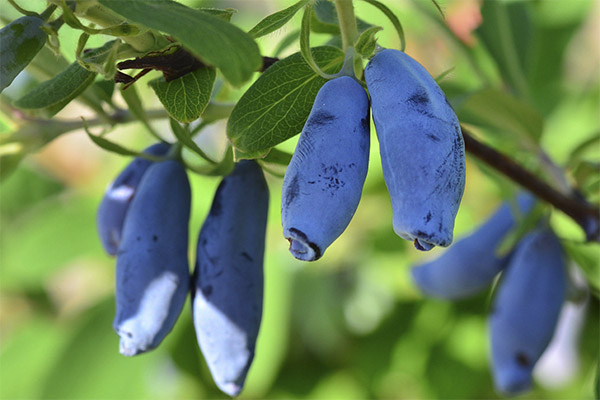
After the fruits are harvested, they should be processed immediately, since they spoil quickly and cannot be stored fresh. They are used to make morsels, compotes, jams and marmalades.
Can they be frozen?
Many gardeners today prefer not to bother with preparations, but to freeze the harvest. Beginning gardeners are interested in the question of whether it is possible to freeze honeysuckle. The answer, of course, is yes. The berries are perfectly preserved in the freezer and can then be used to make juices and compotes. They are also used in the preparation of pies, buns, desserts, and use in cosmetology for masks and products to strengthen the hair.
Before freezing the berries are sorted out and washed under cool running water. Then they are spread out on a gauze or paper towel in a single layer, dried and put into containers.
Honeysuckle berries can be frozen either in special plastic containers or in polyethylene bags. For freezing, choose only ripe berries without damage.
Can I Dry them?
In folk medicine, you can find recipes when dried honeysuckle berries are used. They are dried in the sun or in a special electric dryer.
After drying, they are poured into a cloth bag and stored in a cool dry place. Berries are used to make infusions, brew tea. They even after drying do not lose their useful properties.
What can be cooked from honeysuckle: recipes
From honeysuckle prepare a lot of different desserts, which can be eaten all winter. From berries cook jam, jams and even make wine.
Jam
Recipe №1
For cooking, use whole, undamaged fruits that are sufficiently ripe. Then the jam will have a sweet and sour taste and a wonderful aroma. For this, 1 kg of berries and sugar are prepared in advance, as well as jars, which are important to scald with boiling water or hold in a water bath for sterilization.
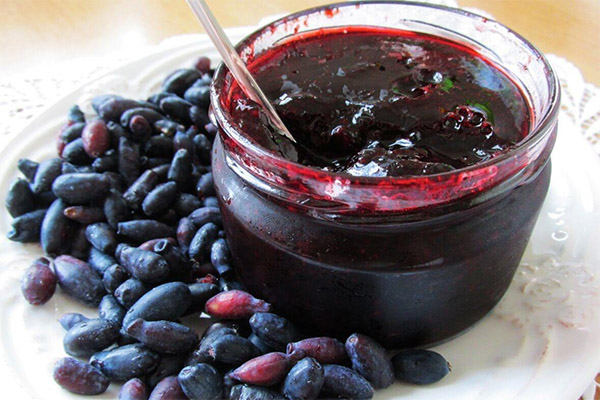
Pour the sugar into a pot and pour a little water, boil the syrup. Before it cools, add berries, which should be pre-selected, washed and dried. Bring the jam to a boil, stirring constantly. After 10-15 minutes, turn it off and repeat the boiling after the contents have cooled. Then pour into jars.
Recipe number 2
Honeysuckle jam is made not only with only berries. Citrus fruits can also be added to it. For preparation, the following components will be required:
- 1 kg of berries.
- One lemon or orange.
- 1.5 cups of water.
- 1 kg of granulated sugar. You can also use 1.5 kg.
The berries are sorted and washed, then dried. Orange or lemon peel and remove the seeds. Honeysuckle fruits are crushed to a smooth consistency with a mixer. In the resulting mass add orange or lemon, granulated sugar and mix thoroughly. The mixture is left in the refrigerator overnight. The next day, boil the mass for five minutes over medium heat and pour into jars.
Jam
Honeysuckle jam will delight not only children, but will be to the taste of adults. It can be used as a dessert and in the preparation of baked goods. Due to the properties of honeysuckle, it is excellent for supporting the immune system. You can make jam with or without berry seeds, depending on personal preferences and the desired consistency of the finished product.
Recipe #1
Use ripe honeysuckle berries in an amount of 1 kg and 2 kg of sugar. Preparation is carried out in stages:
- Peel and wash the berries. Use ripe fruit that are untouched by rot and insects.
- Transfer the fruit to a saucepan and cover with sugar.
- Put the container on medium heat and bring to a boil.
- Reduce the power of heating the stove so that the boiling was minimal. Boil for 15 minutes.
- Remove the pot from the heat and cool the mass.
- If you plan to make seedless jam, grind the mixture through gauze or a fine sieve.
- Repeat the boiling over low heat. In the process, a foam will form, which should be removed, as it may contain twigs and other debris that was not removed during washing and plucking.
- When the mass of the jam is reduced by one-third, remove the pan from the heat.
- Pour the contents into pre-prepared jars.
Sterilize jars can be done in several ways: in the oven, in the microwave or in a water bath.
Recipe #2
When making jam from honeysuckle, you can also add strawberries. It will turn out more sweet, with a rich flavor. The following ingredients will be required:
- 400 ml of water.
- 20 grams of gelatin.
- 1,5 kg of sugar.
- 1.5 kg strawberries.
- 1 kg of honeysuckle.
Picking honeysuckle berries, removing damaged and rotten fruits. Then they are washed under running water and poured into a saucepan. Add water and cook over low heat for 5 minutes. After the mass cools, it is rubbed through a sieve.
Strawberries are also sorted, remove the leaves and rinse. Pour the berries into a bowl and using a blender make a puree. The resulting mass is added to the honeysuckle, pour sugar and leave for half an hour.
During this time prepare the gelatin. It is poured into a small container, pour water and leave to swell. Slightly cooled mass of berries is put back on low heat and brought to a boil. After 15 minutes after boiling a thin stream of gelatin is added and boiled for 3 minutes. After that, jam poured into jars, which are tightly covered and wrapped, leaving until it cools down.
It is important to know that after the berries are washed, they should be thoroughly dried. You can do this with gauze or paper towel. So the jam will turn out more delicious and fragrant.
Compote .
Honeysuckle compotes are also useful for health. They are a great thirst quencher and increase immunity.
Recipe 1
Traditional honeysuckle compote consists of berries, granulated sugar and water. The taste of the finished product will depend on the proportions and method of preparation. This recipe is suitable for making a drink that can be stored during the winter.
For one liter of water, you will need one-third of a cup of berries and 300 grams of sugar. The fruits must be whole, undamaged and fairly ripe.
In the first place syrup is prepared. Then add the berries and boil everything for 2 minutes. The compote insist at least 10 minutes, and then poured into jars.
Recipe number 2
In honeysuckle compote you can also add apples. It will be more tasty and sweet. To prepare it, you will need the following ingredients:
- 1 kg of ripe sweet apples.
- 2 liters of water.
- 1 kg of honeysuckle.
- 1,5 kg granulated sugar.
Pour the water into a pot and bring it to a boil, then add sugar. For 15 minutes, the syrup is infused over low heat. Then dipped into it apple slices and honeysuckle berries, leave for 2 hours.
Mors
Morse, like compote, helps to cope with thirst. It can be drunk chilled or heated. To prepare it, you will need the following products:
- 1 liter of water.
- A glass of fresh and ripe berries.
- 3 tablespoons of honey. It can be replaced by sugar.
The berries are cleaned of debris, washed under running water, poured into a saucepan, add water and sugar. Bring the morsel to a boil and boil for 15 minutes. Be sure to remove the foam during cooking.
Morsels do not store in the winter, but it can be made from frozen berries or pureed with sugar. Before cooking them thaw at room temperature.
Wine
Honeysuckle wine is also very popular. It has a tart taste and aroma, has many medicinal properties, but it is not easy to prepare. The process consists of several steps:
- Grind 2 kg of berries with a blender until mashed.
- Add 350 grams of granulated sugar and 2 liters of water.
- Cover the pot with gauze and leave it in a dark place for 4 days. During this time, it is necessary to stir the wine regularly.
- Strain the mixture through gauze and squeeze. Do not use cake, it can be thrown out.
- Add 100 grams of sugar and mix.
- Pour everything into a jar and leave to ferment in a dark place at room temperature. Put a glove on the neck of the bottle, making a hole in one finger.
- After 6 days, drain a small amount of must, and mix it with 150g of sugar.
- Pour the must back into the bottle and leave it for 6 days, then repeat the procedure.
After 2 months, remove the must from the rest and pour it into bottles, where it will be stored. It is important to check the bottles regularly for sediment.
Is it possible to eat ornamental honeysuckle berries
Many novice gardeners are interested in the question of whether it is possible to eat berries that grow on ornamental honeysuckle. Experts do not recommend eating them. The thing is that not all fruits are edible, because they are poisonous. After their consumption, unpleasant symptoms such as fever, diarrhea, nausea, vomiting, cramps can occur.
If poisoned by ornamental honeysuckle berries, the stomach should be flushed and an ambulance should be called. Timely medical attention will avoid the occurrence of unpleasant consequences.
Interesting facts about honeysuckle
Such a plant as honeysuckle began to appear on garden plots in Russia at the beginning of the last century. Since then, breeders have been selecting the best varieties and creating new ones. Honeysuckle can be found in temperate latitudes and is common in North America, India and even Siberia. Here are some interesting facts about the plant:
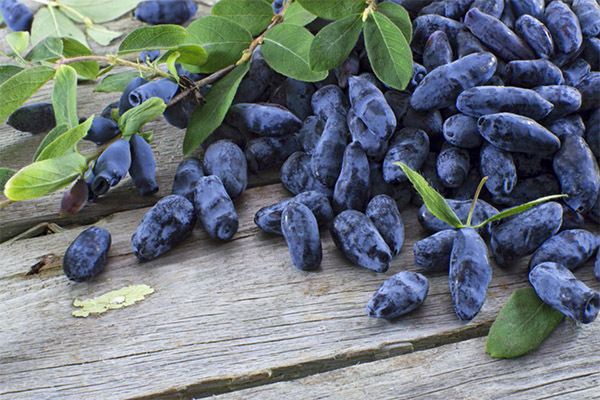
- Breeders have bred three main species: upright, creeping and creeping. But shrubs whose berries can be eaten are only upright.
- Ornamental plants are distinguished by the small size of berries, which come in purple-blue, red, black or blue. The surface is covered with a patina that makes them matte.
- The plants can reach a height of up to 2.5 meters. The shortest ones do not exceed 40 centimeters in height.
- The fruits of most varieties have a bitter taste. Among them, there are berries that are strictly forbidden to eat, as they are poisonous. Popularly, they are called "wolfberries.
- Honeysuckle also grows in New Zealand.
- Honeysuckle belongs to the genus Lonitzer, which was named after the German botanist, physicist and mathematician Adam Lonitzer.
- Specialists know about 250 species, almost all of which can be found in the Northern Hemisphere, as well as in East Asia and the Himalayas.
- In Russia, only 14 species have acclimatized and earned popularity. All of them are decorative.
- There are also quite edible varieties that can be found in Russia. Fruits have a unique taste and a wonderful aroma.
- According to popular belief, the smell of berries helps to relieve stress and irritability.
- Some varieties of bark eventually peel off. People call them "shameless".
- Edible varieties of honeysuckle have a rather unusual, sour-sweet taste. They are used to make compotes, morsels, jams, jellies, jams, jams, juices, and wines. Berries are excellent for freezing and drying.
- Fruits contain many useful substances and have a positive effect on the cardiovascular system, have anti-inflammatory effects, and help to eliminate excess water from the body.
- Berries are used not only in folk medicine, but also in modern cosmetology. On their basis create masks, creams, lotions, shampoos and other means.
- Leaves are used to heal wounds and burns. They also have antiseptic properties. They are used fresh or make a tincture from them, which treat the places of injury.
- Honeysuckle cures diseases of the gastrointestinal tract, it envelopes the mucosa and protects it from the negative effects of a number of factors.
Honeysuckle is popular not only in Russia. It can be found in many other countries. It is widely used in cooking. The fruits make delicious morsels and compotes, jams, jams and jellies. Berries can be added to porridges, various desserts. They can be safely consumed by people who have diabetes and are on a diet to lose weight.
In addition, honeysuckle is also used in folk medicine. For the preparation of medicines are used not only berries, but also branches, leaves and bark. Due to its properties, honeysuckle can cope with many diseases and eliminate a number of unpleasant symptoms. But apply the recipes of folk medicine should be used with caution and after consultation with your doctor. This is necessary in order to exclude a possible risk.
Honeysuckle is also used in cosmetology. It is used to make various remedies for skin and hair care, since it includes many substances that help prevent the aging process, return the skin youthfulness and elasticity, and the hair - the shine and strength.
Honeysuckle is especially beneficial for children, as it boosts immunity. It contains a large number of different vitamins and trace elements, which are necessary for the body to resist viruses and germs. It is also useful during the season of colds, helping to fight the unpleasant symptoms of flu and acute respiratory infections. Thus, honeysuckle is a real treasure trove of useful properties. But it is necessary to consume it correctly, in order to exclude the development of negative consequences arising from exceeding the daily dosage.
«Important: All the information on this site is provided solely for introductory purposes. Consult a specialist before applying any recommendations. should be consulted with a health care professional before any recommendations are used. Neither the editors nor the authors shall be liable for any possible harm caused by materials."

